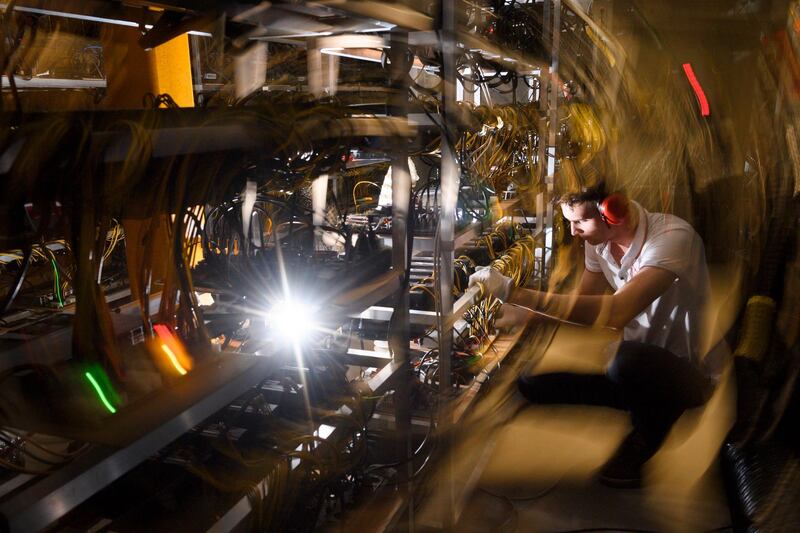This year marks blockchain´s 10th birthday, after Satoshi Nakamoto created it with the purpose of using it for the first cryptocurrency ever, Bitcoin, and Dubai has become a leader in the field.
“Dubai is a pioneer in the blockchain space, says Mohamed Rashid, the co-founder and chief technical officer at WaveX, a peer-to-peer crowdfunding and energy trading market place.
Blockchain technology consists of a decentralised, distributed public digital ledger to record transactions, verified by miners to avoid duplications. Since its creation, blockchain has ushered in a new raft of applications.
Mr Rashid also works full-time as an implementation consultant for blockchain projects at Avanza Innovations in Dubai, which, according to the company, "builds future-proof tech that reshapes how organisations function, today and beyond".
"In Avanza Innovations we are building a blockchain agnostic adaptor called Cipher that has the capability to communicate with any underlying blockchain technologies," he says. "Cipher is currently being used in a Dubai Pay reconciliation and settlement project done by Avanza. Moreover, at WaveX, we are trying to democratise the electricity industry by giving people investment opportunities in utility industry and the ability to sell any excess electricity.
"We are currently in the live testing phase with the help Ajman University’s Innovation Center, and will be out of the testing phase soon,” he says.
Mr Rashid says the fundamental goal of blockchain is, in his opinion, “to bring power to the masses, and it is slowly achieving that goal”.
Blockchain is today present in many sectors; from securing property rights in the real estate lifecycle, in tracking shipments in the transport industry, in the healthcare sector to create a common database of health information that doctors and providers can access, in fintech through solutions for borrowing money or buying cryptocurrencies, in digital commerce for more secure shopping, in smart cities, to digital personal identification, verifying the academic data of overseas students and of labourers hired to work from abroad, and in the energy sector through smart solutions enabling resources to be used more efficiently.
Mr Rashid says he was introduced to blockchain development in late 2016 during the Blockchain Hackathon organised by World Government Summit. “I was [working] in sustainability for some time, and I wanted to bring the power of blockchain to help the environment and create a new economy powered by people,” Mr Rashid says.
Nevertheless, he sees power requirements, speed of transactions and fees as among the limitations of the technology at present: “High energy consumption for proof of work [PoW] based algorithms, and high transaction confirmation times are some of the big challenges." PoW is an economic measure to deter denial of service attacks and other service abuses such as spam on a network by requiring some work from the service requester, usually meaning processing time by a computer.
"Moreover, increasing transaction fees is also another hurdle, but the community is actively working on coming up with technologies to overcome these problems.”
Youssef El Allali, an artificial intelligence (AI) and blockchain developer at Dubai-based ArabianChain Technology, concurs. His says he first came into contact with blockchain via bitcoin five years ago: “I was really fascinated by this new trust protocol that allows anyone to make transactions anonymously and with very acceptable fees. But, he says, "With time, problems started to pop up. First, mining becomes centralised and only people with asic-mining devices were able to profit from it, transaction fees went high, and the number of unconfirmed transactions was skyrocking.”
New blockchains emerged trying to solve some of the bitcoin’s issues, he says, as others aimed to expand the use and application of the technology. “It lead to great innovation, new consensus algorithms, smart contracts, DApps [Decentralised Applications], and permissioned blockchains. Those blockchains had very interesting features but a very big limitation: scalability,” Mr El Allali points out. Blockchain tech for Bitcoin suffers from blockages. “Bitcoin makes seven transactions per second,” Mr El Allali says. Ethereum approves 13 transactions per second, Paypal makes 115, and Visa reaches to 4,000.
______________
Read more:
WATCH: The crypto factor - South Korean students chasing bitcoin investments
WEF's Sheila Warren: blockchain is the door to new digital reality
______________
One new technology that appears to address the issue of scalability is Iota, a cryptocurrency but, unlike just about every other cryptocurrency, it's not built on a blockchain. Aiming to design a distributed ledger that's low-cost and scalable enough for the Internet of Things (IoT), the project's developers started from scratch in 2016 and built a new sort of structure they call the "Tangle".
Every time a node wants to transfer some value, it must validate two previous transactions. This validation requires a small amount of PoW in order to secure the network, meaning that transactions are not strictly free. But, since there is no distinct group of miners who must be compensated, there are no fees with Iota. Proponents argue that this no-fee structure enables the kind of microtransactions that would be impossible with Bitcoin.
Sceptics point out that while the Iota Foundation has built a working Tangle - the only one - there is a gulf between the ideal of the Tangle and the reality of Iota. The developers face a number of challenges in getting their technology ready for the IoT, and some of their decisions have attracted strong criticism.
Iota is a public distributed ledger that stores transactions in a directed acyclic graph (Dag) structure, and removes the cost of the energy inefficient mining process required by many Bitcoin-based cryptocurrencies and it grows via transactors, not miners, thus avoiding centralisation.
Its makers are aiming for it to be the backbone of the emerging machine-to-machine (m2m) economy of the IoT, data integrity, micro-/nano payments, and other cases where a scalable decentralised system adds value.
“Iota’s network becomes faster with more transactions, which is the exact opposite in the case of blockchain," Mr El Allali says. "Also, a node only needs a small part of the Dag to make transactions and you can make transactions without fees." He adds that Iota networks can handle more than 500 transactions per second, and he expects Iota will expand as more people and entities take it up, making it a better solution for m2m and micro transactions.
As a way to compare the two technologies, blockchain works like a restaurant where customers are served by a finite number of waiters while Tangle offers a buffet where everyone is served at the same time, so increasing the number of machines running Iota will speed up the network. Transactions can be validated from any device: phone, car, even smart fridge.
Iota's proposed application, IoT, could benefit enormously from a network able to complete high volumes of minute transactions, according to a report by Nasdaq.com. Making that network trustless and distributed, as Iota aims to do, could open up new economic possibilities. A smart device could "pay its assembly, its maintenance, its energy and also for its liability insurance by giving data, computing power, storage or physical services to other machines", Carsten Stöcker and Kerstin Eichmann of innogy wrote in a post on Iota’s blog.
But Iota is likely to be an alternative to blockchain rather than erdicate it, as a lot of hardware will be necessary as more people and machines join the Tangle: “Iota, or Dag distributed systems in general, have great potential in the Internet of Things [world] and for micro transactions, but I don’t think it will replace blockchain," says Mr El Allali.





